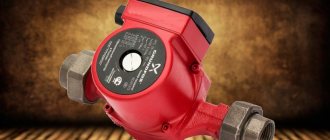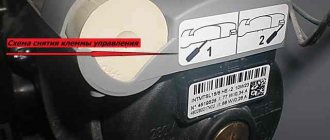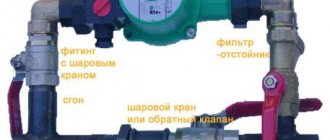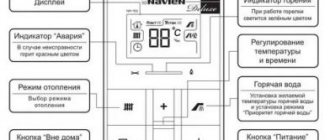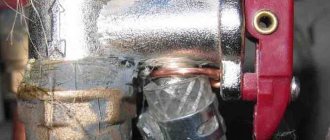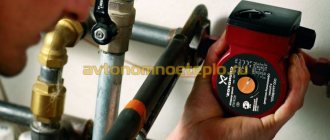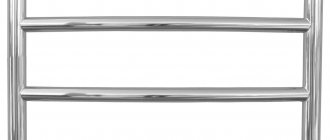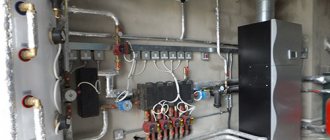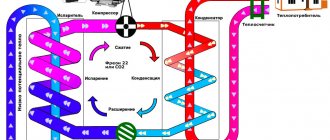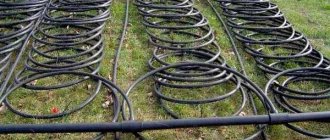Not everyone understands that in order to maintain a normal temperature in a room, not only a heating boiler and pipes with radiators are required, but also a whole series of rather complex instruments and devices, without which there will simply be no heat. One of these indispensable devices is, of course, circulation pump. And although it is better to entrust its selection and installation to specialists, home owners should also be aware of the topic. It must be said that the correct selection of a pump is a guarantee that you will be able to avoid various failures during the operation of the heating system. In addition, such a unit will save electrical energy, and it will also reduce noise in radiators and in the pipeline. And, of course, the circulation pump will increase the overall heat transfer of the system. You can warm a room the old-fashioned way using a stove or fireplace; you can install an electric heater in each room, but such heating is not the topic of this site. Our topic is comfortable hydraulic (liquid) heating systems in which coolant circulates, warming the house with the help of heating devices.
If the total area of the heated premises amounts to hundreds of square meters and if these same meters occupy several floors, then classical heating based on the natural circulation of the coolant will not be enough. And this is not surprising - the pressure in systems with natural circulation does not exceed 0.6 mPa. There are only two ways to increase pressure and improve water circulation in such heating systems - build a closed system with large-diameter pipes or introduce a circulation pump into it. Large-diameter pipes are expensive, so the best solution for heating areas of 100-150 m2 is a circulation pump. The quality of a heating system is understood as the ability of the system to maintain a comfortable temperature in the house at a coolant temperature as low as possible. Heat is transferred to heating devices through pipes connecting the boiler and radiators into a closed network - a heating system through which the coolant circulates.
Design and principle of operation of the circulation pump
A circulation pump is a small unit that is installed directly into the pipeline and ensures pumping of coolant through the pipeline. For heating systems of private houses, pumps with the so-called “wet rotor” are usually used. These pumps are called circulation pumps. Circulation pumps have a narrow specialization - they are designed for forced circulation of coolant (water) in closed heating systems. The circulation pump consists of a cast iron body, inside of which there is a rotor (rotating part) and an impeller mounted on the rotor. The rotor rotates and the impeller moves water. One of the basic rules for installing a pump in a system: the rotor axis must be horizontal. Being installed in a heating system, the pump sucks in water from one side and forces it into the pipeline on the other due to the centrifugal force that occurs when the impeller rotates; a vacuum occurs in the inlet pipe, and compression occurs in the outlet pipe. When the pump operates evenly, the coolant level in the expansion tank does not change, i.e. it will not be possible to increase the pressure in the heating system - to complete this task you will need a booster pump . The task of the circulation pump is to overcome the resistance that arises in certain areas of the heating systems.
Selection, installation
The calculation of the circulation pump determines the main parameters of the unit. In addition to the calculated values, you should pay attention to the place where you need to install the pump. The dimensions and layout do not make it possible to arrange a separate room of appropriate size for installing a pump in the heating system of a private house. The usual location is in spaces with difficult access, in corners, along walls. Before purchasing, you should review the documentation on how to correctly position the device in spatial position. Many heating pumps have limitations on this point.
It is imperative to take into account the overall dimensions of the device so that the engine and other protruding parts do not rest against the walls.
In the area of the connection points, the heating circulation unit must have free space for grasping the nuts with wrenches, tightening them or loosening them.
It is advisable to connect to the electrical network through a detachable plug-socket connection with the installation of protective devices such as an RCD and a circuit breaker for the maximum permissible current. The supply line must have a grounding conductor. If not, local grounding should be arranged in accordance with the rules of the Electrical Installation Code.
The problem of how to choose a circulation pump is not so difficult. If you have some experience and knowledge, you can solve it yourself. If you are unsure of your capabilities, you should contact a specialist with the question of how to choose a heating pump. Many trading enterprises have competent consultants on staff who help solve most problems. Consultations can be obtained by telephone or by inviting specialists to your home.
Advantages and features of using circulation pumps
Features of modern circulation pumps (CP) are efficiency, durability, small dimensions and noiselessness. When installed correctly, circulation pumps are virtually silent. You can only tell if the pump is working by a slight vibration when you touch it with your hand. How to choose the right circulation pump? It is important to select the correct pump in accordance with the hydraulic parameters of a particular heating system. It is better to entrust this to specialists. First of all, you need to know how much heat you will need to heat your house. This is a rather complex calculation, which includes many parameters and is done by specialists. Everything is important: what kind of windows are installed in the building, how the walls, floors and ceilings are insulated, whether thermostatic valves are provided in the system, etc. and so on. The result of these calculations is the determination of the required volumetric coolant supply in the system (m3/h), according to which the pump is selected. When reconstructing an existing system, it is preferable to use an adjustable pump. Such central heating units independently adapt to changes in flow rate in the system, are practically silent and very economical. You will not be able to independently make calculations for a complex and multi-level heating system! But, if you still decide to try, the calculation formula is given in SNiP 2.04.05-91*. The second very important aspect is the pump pressure. This parameter is directly related to the heating system itself. It will be equal to the total hydraulic resistance of your existing system. In this case, the number of storeys of the building is not taken into account. Perhaps the fastest and easiest way is to select a heating pump from catalogs. This is very convenient, since you will be able to compare the various characteristics of the unit itself, as well as characteristics that will be important when installing the pump and during its direct operation. When choosing a pump for your heating system, take into account one important point. All characteristics obtained in the calculations are calculated for maximum pump operation. However, this mode will be used for a minimum amount of time over the entire service life of the unit. This means that when choosing a circulation pump for heating, it makes sense to lower the parameters a little. It would be correct to choose a pump whose power exceeds that required for a given heating system by 5-10%. By making this decision, you can save not only on the purchase of the pump itself, but also in the future save a lot of money on paying for electricity. And you don’t have to worry that a pump with slightly smaller parameters will not be able to supply heat to the house in severe frosts. Noise from the heating system is another problem. In fact, such a problem may well arise if the pump is selected incorrectly. There is another reason - noise in the pipes due to the presence of air in the system. Therefore, it is worth knowing how to remove it from the heating system. Very often, homeowners are concerned about whether problems will arise when starting the pump after the warm season, when the unit is not in use. Modern heating units can be safely turned off for several months; this will not harm them. Even if deposits appear during downtime, they are very easy to remove from the pump. To do this, an unregulated pump must be switched to maximum speed mode, while an adjustable unit has a release function. Another important point is the materials from which heating pumps are made. The shaft and bearings of modern units are made from ceramics. This allows you to significantly increase the service life of the pump, as well as ensure quiet operation.
Selecting the right unit
To ensure long-term uninterrupted operation of the system, it is better to entrust the selection of equipment to a professional technician.
If you need to install it yourself, you need to take into account some selection criteria; the circulation pump for the heating system must meet important conditions:
- low energy consumption,
- durability,
- uniform heat distribution,
- noiselessness,
- automatic regulation of maximum and minimum pressure,
- sufficient water flow in the heating system.
To do this, it is necessary to calculate the following parameters: the total length of the system line, the material and diameter of the pipes. Take into account the type of heating units and quantity, types of control and shut-off equipment, automation characteristics. The heating circulation pump, which has the function of regulating the frequency and speed of the rotary shaft, is characterized by reduced energy consumption, noiselessness, and durability. An automatic change in the speed occurs when the temperature of the water (glycol mixture) decreases or increases. Retrofitting the device with air vents eliminates the problem of air locks.
Among the many models, professional craftsmen call a popular, cost-effective, low-noise device a Wilo circular pump (Wilo Top and Wilo-Stratos), which has a wet rotor installed inside the coolant pipeline. The low weight of the device allows it to be mounted on the pipe surface without additional supports. The models are high-performance, universal: suitable for any heating system. Popular domestic units are linear units TsVTs, Livgidromash.
Choose a heating pump model that has two or three operating modes, and through testing you will find the optimal option for heating the room.
Approximate circulation calculation: for an area up to 250 sq. m. – the circulated volume of water is 3.5 cubic meters. m. per hour, at a pressure pressure of 0.4 atm.
Increasing the area to 350 sq. m. requires 4.5 cubic meters. m per hour and 0.6 atm.
If the area exceeds 350 sq. m, close to 800 sq. m. you need permission up to 10 cubic meters. m., at 0.8 atm.
When the room in the house is larger, it is necessary to install an additional pump in the heating system.
The correct installation of the pump influences the smooth functioning of the device.
Types of circulation pumps
The most common types are circulation pumps with a “dry” rotor and a “wet” rotor. Circulation pumps with a dry rotor include monoblock, cantilever, and Inline pumps. Guaranteed tightness of this type of pump is ensured by the presence of a sliding mechanical seal. In the first type of construction, the rotor is not in contact with the pumped water; its working part is separated from the electric motor by sealing rings, most often made of carbon agglomerate, less often of stainless steel or ceramics, aluminum oxide or tungsten carbide (the material of the mechanical seal depends on the type of coolant). When the pump engine starts, the O-rings rotate relative to each other - between the polished and carefully fitted rings there is a thin layer of water film, which seals the connection due to the difference in pressure in the external atmosphere and in the heating system (in the heating system the pressure is higher). The spring pushes one o-ring to the other, during operation the rings wear out and self-adjust to each other, their service life will be at least 3 years - they are more efficient than the stuffing box, which requires constant lubrication and cooling. Dry rotor pumps make loud noise during operation, so they are installed in a separate room with good sound insulation. When using pumps with a dry rotor with sliding mechanical seals, you should carefully monitor the presence of suspended matter in the pumped water and the dust content of the air in the room where the pump itself is installed. The operation of a “dry” pump causes air turbulence that attracts dust particles - dust particles and suspended matter in the coolant can damage the surfaces of the seal rings, compromising their tightness. Regardless of the type of seal, be it stuffing box or sliding mechanical seal, they are destroyed during the operation of a “dry” pump, so they require the presence of liquid to act as a lubricant - in its absence, destruction of the mechanical seal is inevitable.
Currently, circulation pumps with a “wet” rotor . They are adjustable and have high performance, which allows the use of smaller cross-section pipelines in heating systems and easy control of system parameters. A special feature of these pumps is the absence of gland seals, as well as the lubrication and cooling of the built-in electric motor by the fluid being moved. All models of “wet” type pumps do not require centering during installation and do not require maintenance for many years. They are silent, unlike “dry” type pumps, where rather noisy fans are used to cool external electric motors, do not require maintenance for years, and are easier to repair and configure. The only drawback of pumps with a “wet” rotor is their low efficiency. (no more than 50%), which determines only the domestic scope of their application. However, the costs of energy losses are completely uncritical, and are fully compensated by the undoubted advantages of this type of pumps, which are indispensable for equipping heating and hot water supply systems for country houses.
Design of circulation pumps with a “wet rotor”
Modern “wet” circulation pumps have a modular design:
- pump housing;
- electric motor with stator;
- box with terminal blocks;
- Working wheel;
- a cartouche containing a rotor and a shaft with bearings.
A single cartouche block makes it easy to eliminate air accumulated in the pump housing during startup, and the modular design itself facilitates repair work - you just need to replace the faulty module with a new one.
Dry rotor pumps
Another type of circulation pump is designed in such a way that its rotors are protected from direct contact with the coolant. Typically, such models are much more powerful than the previous version; they are capable of pumping quite large volumes of water, so they are in demand when equipping heating systems in large rooms.
One of the main differences between a moisture-proof heating circulation pump and a device with a wet rotor is not only the principle of placement of the motor, but also the ability to replace the motor with a component with a higher power, if necessary.
Models of circulation pumps in this group differ in the type of connection to the engine. Centrifugal pumps can be coupling or flanged.
How to install a circulation pump. Installation rules
Circulation pumps in modern closed systems (with a membrane tank) are best installed on the return pipeline and as close as possible to the expansion membrane tank. The most common mistake is incorrect installation of the pump on the pipeline, which can lead to a significant reduction in the service life of the pump or its failure. It must be installed so that the motor shaft is horizontal. The pump terminal module must be on top. The system must be flushed and solid particles removed. Before starting a manually adjusted pump, people often forget to vent it, which actually leads to “dry running”. After removing air from the pump and turning it on after a few minutes of operation, it is necessary to stop the pump and re-air it. What is bypass? The bypass used in heating systems is a small section of pipeline installed parallel to the shut-off and control valves; its task is to switch the heating system to natural circulation in the event of a power failure or pump breakdown. For normal operation of heating devices, the diameter of the bypass pipe must be equal to the diameter of the riser into which it cuts. The order of installing devices on the bypass, in the direction of the coolant: filter, check valve (if necessary) and circulation pump. For efficient operation of the “wet” pump and to prevent air accumulation, the bypass is installed strictly horizontally. Just in case, you can install an automatic air vent among the devices installed on the bypass - in any place, it doesn’t matter, but in a vertical position. The advantages of an automatic air vent over the classic Mayevsky valve are that the release and subsequent shut-off of this device is carried out automatically.
The largest suppliers of household and industrial pumps for heating systems on the Russian market are the Italian and Danish Grundfos. Purchasing a circulation pump from an unknown company leads to a high risk of pump failure and, consequently, “unfreezing” of the system, to significant material damage associated with replacing heating radiators, boilers, etc.
Moscow specialists will help you choose, buy, and install a heating system correctly, and will find an acceptable solution at a price. Ask any questions you are interested in, a telephone consultation is absolutely free, or use the “Feedback” . You will be satisfied working with us!
- Back
- Forward
What to consider when installing the device
The ideal option for an autonomous heating system is a throttleless wet circulation pump. The working fluid acts as a lubricant and cooler, so the device lasts a long time, rarely breaks, and does not require special maintenance. If the model is of high quality, selected and installed correctly, then replacement will be needed only after 10-20 years.
When purchasing, you should carefully read the technical documentation and the manufacturer’s recommendations for installation and operation of the device. Each model has its own characteristics, but the basic installation rules for all circulation pumps are the same:
- The location of the working shaft must be strictly horizontal. Any deviations can lead to the formation of air pockets, which will prevent the coolant from properly washing the bearings.
- The pump must be installed taking into account the direction of movement of the coolant, which is indicated by the arrow on the device body.
- The installation location can be chosen either in front of the boiler or on the return line. The second option is preferable, because The device operates in more comfortable temperature conditions, which makes it last longer.
- In collector heating systems, separate pumps must be installed for each circuit.
Circulation pump in the heating system
When and why do you need to install a circulation pump in the heating system?
Quite often it happens that an old heating system, operating on the principle of natural circulation of the coolant - water, ceases to cope with heating the house. Sometimes, the heating system is initially designed incorrectly and requires much more fuel (gas, coal, wood, etc.). You may not have noticed this, but when you compare the fuel costs of heating a similar house at your neighbor’s, you realize that “something is wrong somewhere.” Is it possible to increase the efficiency of an existing heating system without high costs? In most cases, yes.
One of the reasons for a decrease in the efficiency of the heating system may be a gradual change in the heating circuit as a result of repairs and alterations, as well as the growth of internal walls with rust and scale. As a result, the diameters of the pipes decrease and the roughness of the internal walls increases, which leads to an increase in the hydraulic resistance of the heating system and a loss of circulation in it completely, or in some areas. A natural circulation system must have a slope along the entire length of the pipeline. This slope can change within a year or two after the house is built as a result of subsidence of the foundation.
A radical remedy for such a heating system is a complete rework. But this is not always possible; moreover, it is associated with significant costs and subsequent restoration of the premises.
Another way is to limit yourself to minimal surgical intervention - inserting a circulation pump .
Modern circulation pumps for small private houses are inexpensive, reliable, silent and economical, so installing a pump in the heating system is also worthwhile for preventive purposes, to revive the old gravity heating system with natural circulation and give it vitality and a second youth.
Almost always, after installing a pump in the heating system, you will receive an increase in boiler efficiency. In addition, the room heats up several times faster and evenly. This is especially noticeable in the off-season, when the boiler does not turn on constantly but when necessary. All rooms will warm up quickly and evenly. All this saves fuel costs and quite significantly.
The main advantages of installing a circulation pump in a heating system
- increasing system efficiency;
- rapid heating of air in all rooms, increasing the heated area;
- equalization of temperature indicators in the pipeline;
- elimination of airiness in pipes;
- reduced fuel consumption;
- possibility of installing heated towel rails, thermostats;
- use of small diameter pipes;
- low cost of equipment and installation.
A circulation pump is an opportunity to quickly improve the quality of home heating without dismantling the entire system and large financial expenses.
The only disadvantage of this solution is the dependence of the pumping equipment on electricity, but the problem is usually solved by connecting a UPS for the circulation pump. Another way is to install the pump using a bypass circuit. Then, in the absence of electricity, you can switch to operating the circuit without a pump. This scheme will be discussed in more detail below.
Installing a pump in the heating system of a private home is justified both when creating a new one and when modifying an existing heating system. Heating systems with forced circulation of coolant provide faster and more uniform heating of all sections of the water circuit, regardless of the distance from the water heating unit.
Where to install the circulation pump?
If you have a solid fuel boiler, then when installing a pump into an existing system, it is best to install it on the return line, next to the boiler, so that it is not negatively affected by too high water temperature in the supply from the boiler fired at full power. To maintain the ability of the boiler to operate without a circulation pump, it is advisable to install the pump using a bypass circuit - this is a bypass section of the main line, which provides the ability to switch the heating system to natural circulation, bypassing the pump.
You can make a bypass unit yourself, or purchase a ready-made one; they are often available for sale in semi-handicraft markets. Do not be afraid that it will not fit the pump you purchased. It is enough to measure the installation size of the gap in the bypass assembly, between the ball valve and the filter, intended for installing the pump. It should be 180 millimeters.
The standard size of the circulation pump is exactly 180 millimeters. There are also short versions, 130 millimeters, designed for installation in quick-installation pump units, but such pumps are practically not found in the regular retail network.
Important! When using a bypass circuit to install a pump, the outlet to the expansion tank and the safety valve MUST be cut in before or after the valves that cut off the pumping or bypass section. The expansion tank and safety valve must not be cut off from the heating system in any operating scheme, pump or natural!
What needs to be done before installing the pump in the heating system?
So, as you remember, you have an old heating system, full of sludge and rust, which must be removed if possible. In most cases, only basic flushing is available. Simply draining the water from the system is not enough, since it is drained through a small-diameter drain valve. At the same time, water moves through the system very slowly, because the main diameters of the pipelines are much larger than the diameter of the drain valve and all sludge and rust calmly settle in the pipe.
Steel pipes are most prone to clogging. This is due to their rough surface, which only becomes more and more imperfect over the years. Polypropylene, plastic, galvanized pipes are smoother and less susceptible to rust settling on them - it is simply washed away by the flow of coolant.
Therefore, when you have opened the return pipeline, cutting out an area for installing the pump, flush the system by connecting it to the water supply through hoses. Try to ensure maximum flow through the heating system, with the highest possible pressure. You still won’t be able to create a good high-speed flow in large-diameter pipes, so spend a little more time on flushing than you would like, let the maximum possible amount of sludge and rust flow out.
How to choose a circulation pump for installation in a heating system with natural circulation?
An important point that needs to be given some attention. When designing new systems, pumps are selected based on the total thermal power of the heating system, the total coolant flow (flow rate) through the system required for such power is determined, and the required performance of the circulation pump is equated to it.
Next, calculate the total hydraulic resistance of the heating system and calculate the required pressure of the circulation pump . Full calculations are complex and are not necessary for a small private house. For small houses (and for large ones too) there are calculation methods that are simplified and accessible even to completely untrained people. There are quite a few methods on the Internet - choose which one you like best and calculate the parameters for choosing a pump. It is even easier to determine the thermal power of an existing heating system - look at it on the nameplate of the heating boiler.
For buildings with a relatively small area, there is a method for calculating a pump without formulas. independently select the power of the circulation pump as follows:
- According to boiler performance. The calculation of a circulation pump for the heating system of a private house is carried out taking into account that 1 kW of water heating equipment power corresponds to a throughput coefficient of 1 l/min. Accordingly, for a 25 kW boiler, you will need to install a pump with a rating of 1500 l/hour.
- Calculation of the pressure of the circulation pump of the heating system. The technical documentation indicates the pressure parameter in meters of water column. Using this parameter, you can determine the length of the water circuit and calculate the required number of pumps in the system. It is believed that for 10 l.m. pipeline, 0.6 m of water column pressure is required. The optimal choice of pump for a 1-story building is standard models with 6 m.v. Art. The stations are suitable for premises with a pipeline up to 100 running meters. If the pressure is not enough, install a second pump or select a more powerful model. The same calculation principle is used when choosing a pump for a 2-story house.
The main rating parameters of a circulation pump are performance, pressure and flow. First of all, you should be interested in the consumption; it is determined by the formula:
Q= N/(t2-t1)
N is the power of the heat generating unit. If there is no nameplate, very, very approximately, you can take as a basis the average data for the need for thermal energy for heating - 0.1 kW/m2, multiplied by the heated area in m2. t1 – temperature of the coolant at the inlet (return), on average 65 ºС t2 – calculated temperature of the coolant at the outlet (supply), for conventional systems on average 90 ºС.
The pump pressure is approximately determined based on 100 W of power per square meter of area.
It remains to take into account one more important point - the peculiarity of installing the pump in a system with natural circulation .
For a forced circulation system, your old system has very thick pipes. When designing new heating systems, the diameter of the pipes is chosen so that the flow rate in them is in the range from 0.4 to 1.5 meters per second. At a lower speed, air will not be removed from the system and air bubbles will remain hanging in the pipes; at a higher flow speed, the pipes may hum and accelerated wear of the heating system elements. High speed with humming in the pipes will not threaten you, but very low speed, with air poorly removed from the system, is quite likely.
But it is not all that bad. After all, you have a system with, although poor, natural circulation and the system is flushed! Therefore, there is no need to select a pump based on the diameter of the pipes; just take a pump model one step higher in the nomenclature.
.
Types of pumps
There are many types of pumps used to circulate liquids.
In terms of design, these units resemble drainage devices. Their bodies are made of stainless metal. The rotor and shaft (the impeller is mounted on it) are most often made of ceramics. The rotor rotates using an electric motor. Water entering the circulation pump, on one side, is pumped into a pipeline located on the other side. The coolant moves through the system due to centrifugal force. The excess pressure created in the system is aimed at overcoming the resistance that arises in many sections of the pipeline. Circulation pumps, according to their operating principle, can be divided into two subtypes: “wet” and “dry”.
Let us note some features of heating circulation pumps with a so-called “wet” rotor
. The main feature of devices of this type is that the impeller and rotor are located in the pumped liquid. In this case, the wheel (stainless metal) is separated from the stator by a special glass. The pump shaft can be made not only of ceramics, but also of metal. The liquid pumped by the pump simultaneously participates in performing 2 functions: cooling the engine and lubricating the rubbing parts.
Regarding the design features of pumps of this type, we note that their assembly is based on the so-called modular principle. Its essence is as follows. The modules themselves are selected taking into account the requirements for circulation devices. Namely, depending on the required performance and pressure. The modular design of the pump greatly facilitates its repair. In fact, it is carried out by simply replacing a failed module.
You should also pay attention to this circumstance. Using a pump with a “wet” rotor frees the user from the need to regularly remove air from the cochlea by arranging discharge pipes. The pump itself removes air.
The advantages of “wet” type units include:
— relatively low noise level during operation; — small overall dimensions and light weight of the device; — low level of electrical energy consumption; — relatively long period of uninterrupted operation; — ease of setup, maintenance and repair.
The most significant disadvantage of pumps of this type is considered to be its relatively low level of efficiency.
. As a rule, it is less than 50%. This is explained, first of all, by the fact that it is difficult to ensure high-quality sealing of the rotor. Taking into account this fact, such models are naturally recommended to be installed only in heating systems for small private houses. That is, where the total length of pipelines is relatively small.
It should also be remembered that uninterrupted operation of “wet” units is possible only if they are installed correctly
. The main requirement is that the position of the shaft must be strictly horizontal. Only with this arrangement of the shaft is complete water lubrication of the bearings ensured.
In cases where it is necessary to pump large volumes of liquid in various heating systems, devices with dry rotors
. They got their name due to the fact that the engines of such devices do not have direct contact with the pumped liquid. This is their characteristic feature. The pump part and the electric motor are isolated from each other by means of a “sliding mechanical seal”.
The STU (sliding mechanical seal) is based on 2 rings with polished surfaces. One of them, called dynamic, is mounted on a shaft. It rotates with him. The other, called static, is fixedly fixed in the pump housing. The rings are in close contact thanks to a spring that presses them together. For their production, agglomerated coal is usually used. Some models designed for use in extreme conditions use ceramic or metal rings.
STU refers to the so-called dynamic seals. They help seal shafts rotating in liquids. This happens as follows. The space between the surfaces of the rings is filled with a thin liquid film, since the water pressure in the system is higher than atmospheric pressure. Thanks to this film, the pump is sealed. In addition, it acts as a lubricant and cooling agent for contacting surfaces. Under different operating modes of the pumping device, the nature of friction between the surfaces is different. Friction can be of mixed, boundary or dry type. Dry friction occurs in the absence of a lubricating film. It leads to very rapid destruction of rubbing surfaces. In other cases, service life is determined by operating conditions (composition, fluid temperature).
Pumping devices with a “dry” rotor are divided into 3 subtypes.
1. Console. A characteristic feature of cantilever pumps is their assembly mounted on a single platform. In this case, the axes of both the pump and the engine are located along the same line. They are widely used to organize urban water supply and to solve the production needs of enterprises. 2. Monoblock. They belong to the category of low-pressure devices. A common housing is used to install the pump and electric motor. These units are unpretentious in operation and easy to maintain. They are widely used to solve problems in public utilities and in the organization of engineering communications. These two subspecies have a distinctive feature - the location of the inlet and outlet pipes at a certain angle. 3. “In-line” pumps. The main difference between pumps in this category compared to previous models is the possibility of their direct installation on the pipeline. The pipes of such devices are located on the same line. They are characterized by higher reliability. A mechanism is provided to compensate for the natural depletion of rings that occurs as a result of operation. With the help of a pressure spring, “self-fitting” of the parts is carried out.
The efficiency of pumps with a “dry” rotor is noticeably greater than that of analogues with a “wet” rotor.
It sometimes reaches 80%. However, these devices are not without some disadvantages, including: - high noise levels. In this regard, it is recommended to install them in a separate room with good sound insulation; — the obligation to maintain cleanliness of both the coolant and the air inside the room. The occurrence of air turbulence during pump operation leads to the attraction of dust particles. As a result of such particles entering the housing, the seal is broken. Therefore, there is a need to control the level of dust in the air surrounding the pump, as well as the composition of the coolant.
